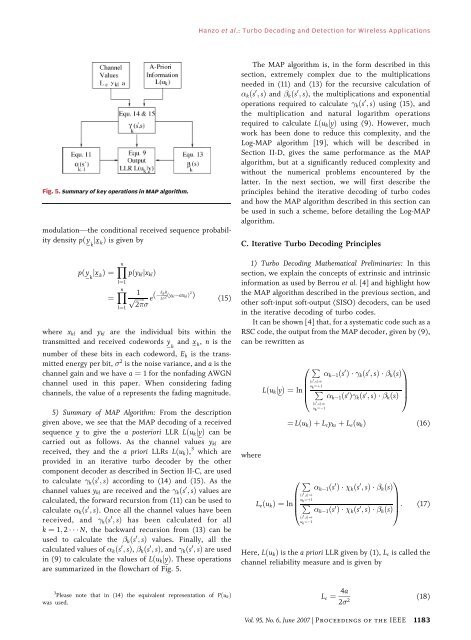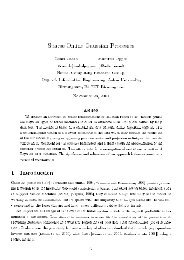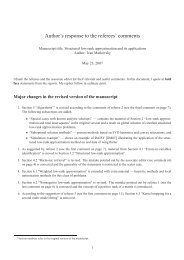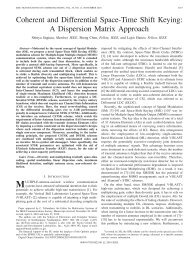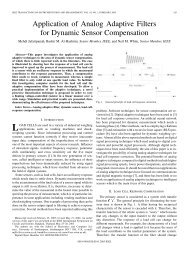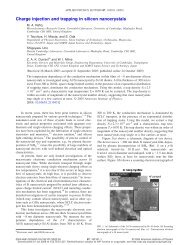Turbo Decoding and Detection for Wireless Applications
Turbo Decoding and Detection for Wireless Applications
Turbo Decoding and Detection for Wireless Applications
You also want an ePaper? Increase the reach of your titles
YUMPU automatically turns print PDFs into web optimized ePapers that Google loves.
Fig. 5. Summary of key operations in MAP algorithm.<br />
modulationVthe conditional received sequence probability<br />
density pðy k jx k Þ is given by<br />
pðy k jx k Þ¼ Yn<br />
l¼1<br />
¼ Yn<br />
l¼1<br />
pðykljxklÞ<br />
1<br />
EbR pffiffiffiffiffi e 2<br />
2<br />
2ðykl axklÞ 2<br />
ð Þ (15)<br />
where xkl <strong>and</strong> ykl are the individual bits within the<br />
transmitted <strong>and</strong> received codewords y<br />
k<br />
<strong>and</strong> x k , n is the<br />
number of these bits in each codeword, Eb is the transmitted<br />
energy per bit, 2 is the noise variance, <strong>and</strong> a is the<br />
channel gain <strong>and</strong> we have a ¼ 1 <strong>for</strong> the nonfading AWGN<br />
channel used in this paper. When considering fading<br />
channels, the value of a represents the fading magnitude.<br />
5) Summary of MAP Algorithm: From the description<br />
given above, we see that the MAP decoding of a received<br />
sequence y to give the a posteriori LLR LðukjyÞ can be<br />
carried out as follows. As the channel values ykl are<br />
received, they <strong>and</strong> the a priori LLRs LðukÞ, 3 which are<br />
provided in an iterative turbo decoder by the other<br />
component decoder as described in Section II-C, are used<br />
to calculate kðs 0 ; sÞ according to (14) <strong>and</strong> (15). As the<br />
channel values ykl are received <strong>and</strong> the kðs 0 ; sÞ values are<br />
calculated, the <strong>for</strong>ward recursion from (11) can be used to<br />
calculate kðs 0 ; sÞ. Onceallthechannelvalueshavebeen<br />
received, <strong>and</strong> kðs 0 ; sÞ has been calculated <strong>for</strong> all<br />
k ¼ 1; 2 N, the backward recursion from (13) can be<br />
used to calculate the kðs 0 ; sÞ values. Finally, all the<br />
calculated values of kðs 0 ; sÞ, kðs 0 ; sÞ, <strong>and</strong> kðs 0 ; sÞ are used<br />
in (9) to calculate the values of LðukjyÞ. Theseoperations<br />
are summarized in the flowchart of Fig. 5.<br />
3<br />
Please note that in (14) the equivalent representation of PðukÞ<br />
was used.<br />
Hanzo et al.: <strong>Turbo</strong> <strong>Decoding</strong> <strong>and</strong> <strong>Detection</strong> <strong>for</strong> <strong>Wireless</strong> <strong>Applications</strong><br />
The MAP algorithm is, in the <strong>for</strong>m described in this<br />
section, extremely complex due to the multiplications<br />
needed in (11) <strong>and</strong> (13) <strong>for</strong> the recursive calculation of<br />
kðs 0 ; sÞ <strong>and</strong> kðs 0 ; sÞ, the multiplications <strong>and</strong> exponential<br />
operations required to calculate kðs 0 ; sÞ using (15), <strong>and</strong><br />
the multiplication <strong>and</strong> natural logarithm operations<br />
required to calculate LðukjyÞ using (9). However, much<br />
work has been done to reduce this complexity, <strong>and</strong> the<br />
Log-MAP algorithm [19], which will be described in<br />
Section II-D, gives the same per<strong>for</strong>mance as the MAP<br />
algorithm, but at a significantly reduced complexity <strong>and</strong><br />
without the numerical problems encountered by the<br />
latter. In the next section, we will first describe the<br />
principles behind the iterative decoding of turbo codes<br />
<strong>and</strong> how the MAP algorithm described in this section can<br />
be used in such a scheme, be<strong>for</strong>e detailing the Log-MAP<br />
algorithm.<br />
C. Iterative <strong>Turbo</strong> <strong>Decoding</strong> Principles<br />
1) <strong>Turbo</strong> <strong>Decoding</strong> Mathematical Preliminaries: In this<br />
section, we explain the concepts of extrinsic <strong>and</strong> intrinsic<br />
in<strong>for</strong>mation as used by Berrou et al. [4] <strong>and</strong> highlight how<br />
the MAP algorithm described in the previous section, <strong>and</strong><br />
other soft-input soft-output (SISO) decoders, can be used<br />
in the iterative decoding of turbo codes.<br />
It can be shown [4] that, <strong>for</strong> a systematic code such as a<br />
RSC code, the output from the MAP decoder, given by (9),<br />
can be rewritten as<br />
where<br />
P<br />
ðs<br />
LðukjyÞ ¼ln<br />
0 k 1ðs<br />
;sÞ)<br />
uk¼þ1 0Þ kðs0 ; sÞ kðsÞ<br />
P<br />
k 1ðs0Þ kðs0 0<br />
1<br />
B<br />
C<br />
B<br />
C<br />
B<br />
C<br />
@<br />
; sÞ kðsÞ A<br />
B<br />
LeðukÞ ¼lnB<br />
P<br />
@<br />
ðs 0 ;sÞ)<br />
u k ¼ 1<br />
¼ LðukÞþLcyks þ LeðukÞ (16)<br />
0 P<br />
ðs0 ;sÞ)<br />
uk¼þ1 ðs 0 ;sÞ)<br />
u k ¼ 1<br />
k 1ðs0Þ kðs0 ; sÞ kðsÞ<br />
k 1ðs0Þ kðs0 1<br />
C<br />
C:<br />
(17)<br />
; sÞ kðsÞA<br />
Here, LðukÞ is the aprioriLLR given by (1), Lc is called the<br />
channel reliability measure <strong>and</strong> is given by<br />
Lc ¼ 4a<br />
2 2<br />
(18)<br />
Vol. 95, No. 6, June 2007 | Proceedings of the IEEE 1183


